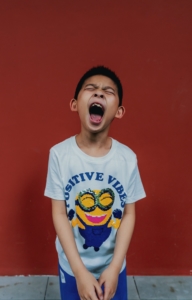Have you recently noticed a change in your child’s behavior? Perhaps your child is engaging in behaviors that you have not previously observed, or certain behaviors may occur more often and with greater intensity than before. The purpose of behavioral treatment for children is to assess why your child is engaging in certain behaviors and to assist them in developing more adaptive skills to replace their current challenging behaviors.
 Children often present differently in therapy than adults. Specifically, children are prone to somatic symptoms and behavioral dysregulation. Children may not have yet developed the skills to express their emotional experience effectively, which can lead to feeling misunderstood and frustrated.
Children often present differently in therapy than adults. Specifically, children are prone to somatic symptoms and behavioral dysregulation. Children may not have yet developed the skills to express their emotional experience effectively, which can lead to feeling misunderstood and frustrated.
It may be easy for adults to begin to label children’s behavioral dysregulation in terms of “good” and “bad.” However, I prefer “helpful” and “unhelpful,” as these allow the focus to remain on the child’s behavior and whether their behavior is in alignment with their goals.
Assess Challenging Behaviors
Behavioral treatment starts by assessing the challenging behavior(s). Early on in treatment, the therapist will collect information to develop more context about the challenging behavior, which will be helpful to develop appropriate interventions. Gathering information may occur through an interview and/or observation of children, parents, and sometimes other relevant adults.
The therapist may utilize an A-B-C approach (antecedent, behavior, consequence). The antecedent is whatever occurs before the behavior, the behavior is clearly defined, and the consequence is anything that occurs following the behavior.
Common reasons children may engage in behaviors include obtaining something tangible, escaping or avoiding an unwanted task, or gaining interaction with others. In addition, it is important to understand what tends to occur before and after the child engages in a behavior, as this provides clearer context as to the reasons for why the behaviors may continue to occur.
It is also important to establish whether challenging behaviors are situational or are consistent across multiple environments and whether the child may need to be referred for psychological testing.
Lastly, there will be a focus on developing a therapeutic relationship with the child because during therapy, they will be challenged to try something different to accomplish their goals while maintaining their relationships with others, and the trust they have with their therapist will help to accomplish this.
Intervention
 Developing interventions that address the challenging behaviors which are developmentally appropriate and strategically reinforced is the next step. It is important to teach parents or guardians the interventions as well, and specific ways to increase the likelihood of the intervention’s effectiveness.
Developing interventions that address the challenging behaviors which are developmentally appropriate and strategically reinforced is the next step. It is important to teach parents or guardians the interventions as well, and specific ways to increase the likelihood of the intervention’s effectiveness.
Specifically, regardless of the intervention itself, a general rule is to attend to the behaviors that you want to see more of and disengage from behaviors that you want to see less of. However, it is important that children understand the reason why someone may be disengaging from them or interacting more with them, as this will help them connect their behaviors to the consequences.
Involving parents is important so that when therapy will end, transitioning out of therapy will go smoothly and the progress made in therapy will be sustained. Practicing the interventions in session will also allow the therapist to provide feedback and in-the-moment coaching to parents to help them become more effective at getting the desired response from their child.
Setting Limits
When setting limits, it is important to remember that expectations for the child need to be clearly communicated, and it is important to ensure that the child understands the expectation and what will occur following their engagement in an unwanted behavior as well as a wanted behavior (again, the aim is to help the child connect their behavior with the consequences that follow).
Problems with limit setting often occur when the expectation is too high or the expectation is too complex for the developmental stage, or the consequences are not followed through on, which may lead to prolonged unhelpful behaviors.
If behaviors become safety issues (physical harm to themselves or others), the therapist may coach parents on developmentally appropriate time-outs for the purpose of the child stopping the behavior, regulating their emotions, and engagement in a discussion about the behavior to assist the child in connecting their behavior to the consequence.
Extinction Burst
The behavior(s) will get worse before it gets better! This phenomenon is known as the extinction burst. The good news is the longer that the intervention continues, the more likely the child’s behavior will change.
 Anticipate this because as the intervention begins to work, there will likely be an increase in the unwanted behavior (outbursts may become louder and more dramatic, property destruction may increase, etc.), and adults are often tempted to fold like a sack of potatoes. However, remember that the increase in the behavior means the intervention is likely working.
Anticipate this because as the intervention begins to work, there will likely be an increase in the unwanted behavior (outbursts may become louder and more dramatic, property destruction may increase, etc.), and adults are often tempted to fold like a sack of potatoes. However, remember that the increase in the behavior means the intervention is likely working.
If the behavior increases in intensity and frequency and the child escapes the unwanted task (making their bed, picking items up off of their bedroom floor, putting their dishes in the dishwasher, etc.), receives preferred interaction (talking about sports, movies, or engaging in playtime), or receives something tangible (preferred food item, tablet time, etc.), this may reinforce (increase the likelihood that the behavior will occur again in the future) the child’s unwanted behavior and will prolong the elimination of the behavior.
Attend
In my opinion, this is where adults often struggle and behavioral treatment for kiddos can help. There is often much attention paid to children’s unwanted behaviors, and not enough provided to children when they are doing well or engaging in neutral behavior.
Lacking in this area can make progress slow. Therefore, when the child is engaging in wanted or even neutral behavior, pay attention to them. Upon them accomplishing a goal or engaging in a helpful behavior, praise them, play a game with them, or engage in a preferred activity of their choosing, etc.
Structure

Structure is especially beneficial to kids and helps them thrive. Whenever possible, provide options to help them retain a sense of control. Also, developmentally appropriate expectations that are clearly explained accompanied by visual and verbal reminders that are readily available to them are especially helpful for their success.
Lastly, consistency is key to sustaining helpful, wanted behaviors over time. When children can anticipate how their environment functions and how to effectively get their wants and needs met, they are more likely to continue to engage in the same behaviors that led to their attainment of the positively experienced consequence (verbal praise and special time with parents, recognition from the teacher, ending a therapy session with a preferred activity, etc.).
Goals and Progress
Goals need to be measurable, and progress needs to be tracked. In addition, it is important to have realistic goals for the child’s behavior given the child’s current developmental stage. If the goals are not developmentally appropriate (expectation too high or too low) or short-term reinforcers are not incorporated, progress will be difficult to achieve and sustain.
Short- and long-term goals are equally important as accomplishing these demonstrates the child is making progress, and when the child achieves these goals, it’s important to celebrate the child’s achievements.
The Importance of Effective Behavioral Treatment for Children
A child’s brain is not fully developed yet, so while they may not have the skills developed to communicate their needs, a range of vocabulary to express their emotions or even the insight into why they are behaving a particular way, they will rely on what works to get their needs met and may need extra support in connecting their behavior with consequences.
When behavioral treatment is effective, children will likely be more emotionally regulated, engage in more socially appropriate ways of getting their needs met, and the parent-child relationship may improve as well.
However, the effectiveness of behavioral treatment will require the adults to change alongside the kids. While the child’s behavior may be why behavioral treatment is sought, the parent’s or guardian’s behavior during and following treatment can help sustain the progress made after therapy has ended.
“Notes”, Courtesy of David Travis, Unsplash.com, CC0 License; “Egg Timer”, Courtesy of Marcelo Leal, Unsplash.com, CC0 License; “Rage”, Courtesy of Xia Yang, Unsplash.com, CC0 License; “Forest Walk” Courtesy of James Wheeler, Unsplash.com, CC0 License










